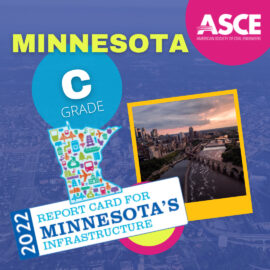Bridges, Roads, Transit
Town of Shakopee Develops Alternative Intersection to Reduce Congestion and Improve Mobility
Shakopee, MN

Infrastructure includes fundamental facilities and systems necessary for Minnesota’s economy to function. Roads, bridges, transit systems, public parks, airports, water and sewer systems, dams, ports, and the energy grid are categories of infrastructure that directly affect our ability to live, work, and play. Infrastructure is the backbone of our state’s economy and integral to preserving our high quality of life here in the Land of 10,000 (+!) Lakes.
Our transportation system gets people to work every day or to visit friends and family on the weekends. Water systems deliver clean drinking water to our communities and businesses. Wastewater treatment systems protect our lakes, rivers, and drinking water sources from contamination.
Much of Minnesota’s infrastructure is aging and reaching the end of its expected lifespan. The majority of our systems were built in the late 20th century, before much of today’s modern technology was developed. New materials, expanded environmental awareness, and increased regulation require improvements to water treatment plants and updates to the energy grid.
The past two years, especially, have shown us how fragile our systems have become. Our infrastructure systems of decades ago need upgrading to better meet and prepare for current and future climate trends, increased use of renewable fuels, a changing population, and an evolving economy.
Broader adoption of asset management systems can help inform systematic operations, maintenance, and upgrades. Comprehensively tracking the age, repairs, and maintenance status of the infrastructure we have will help control and reduce the need for disruptive emergency improvements.
Minnesota must support innovative policies leading to cleaner water distribution, more modality between transportation systems, and a safe and healthy environment that will attract business and improve the quality of life for all Minnesotans.
The 2022 Minnesota Infrastructure Report Card is a simple tool used to help residents, businesses, and policymakers understand the state of Minnesota’s formation helps start the conversation about how to he future of our infrastructure.
The Minnesota aviation system services 2.3 million aircraft operations (takeoffs and landings) annually and includes 133 airports. Nine airports provide commercial airline service and accommodated a record 19.6 million enplanements in 2019, of which 98% occurred at Minneapolis-St. Paul International Airport (MSP). The condition of Minnesota’s runway pavement conditions are acceptable, with ratings falling between 74 and 79 on a 100-point scale. COVID-19 had a significant impact on enplanements in 2020 – reductions were in the 40% to 70% range, which in turn impacted revenue streams for airport improvements and capacity enhancements. In general, however, commercial airport terminals have improved significantly over the last 10 years with minimal capacity issues foreseen in the near future. Safety records are solid, and sustainability is proactively integrated within infrastructure and operational decisions.
There are 874 bridges in poor condition in Minnesota. This is a decrease from 1,080 bridges in poor condition in 2017. While this is encouraging, the number of bridges that have slipped from good to fair condition is growing. As the number of bridges in fair condition increases, it will become more difficult to keep the “poor” bridge percentage small. Meanwhile, more than 1,400 bridges are posted with signs stating they have a reduced or substandard load capacity. In general, bridges in Minnesota need $8.2 billion in funding over the next 20 years for identified rehabilitation and repair needs. Current plans include approximately $4 billion in funding, leaving a shortfall of $4.2 billion, or $210 million each year. Large bridge projects, such as the Blatnik Bridge in Duluth, will require $900 million in funding from Minnesota within a decade.
Dams provide positive benefits to Minnesota. Among them are their contributions to water supply, recreation, hydroelectric power, and environmental protection, with most dams serving more than one purpose. The typical design life for a dam is 50 years and the majority of Minnesota’s dams were built at least 50 years ago. Fortunately, 96% of high-hazard potential dams in the state – dams that, should they fail, would likely result in loss of life and economic damage – have emergency action plans. There are current federal and state programs that support dam rehabilitation and dam removal to promote and protect public health, safety, and welfare. State-regulated dams are typically reliant on state bond funding to provide a stable, predictable funding source for inspection, maintenance, repairs, and rehabilitation.
Approximately 80% of Minnesotans are served by community water systems, while 20% of the population relies on private wells for drinking water. Although drinking water systems in large communities have consistently met federal standards, far less is known about the private wells on which many people in rural Minnesota rely. Meanwhile, much of the drinking water infrastructure in the state is over 50 years old. Some system components are closer to 100 years old and reaching the end of their useful life. The U.S. Environmental Protection Agency estimates the 20-year drinking water infrastructure need for Minnesota at over $7.5 billion. An emerging area of concern is the amount of lead in our drinking water, which is caused by lead service lines. Recently, Minnesota increased the Safe Drinking Water Connection Fee from $6.36 to $9.72 per service connection per year starting in 2020, which will restore $80 million over 20 years for local infrastructure needs.
In 2020, nearly one-third of Minnesota’s electricity was produced by renewable energy. That is almost a five-fold increase from 2005 and puts Minnesota ahead of many other states. However, growth in renewable energy generation must be met with investments in the transmission system – the “interstate highway” of the electric grid. There are two transmission upgrades planned in Minnesota totaling $68 million that will enhance capacity in the system. Meanwhile, the distribution system – the “last mile” of the electric grid – also needs investment to ensure reliability in the face of increasingly severe storms. Minnesota’s residential electricity rates are increasing to help fund necessary improvements, but rate growth from 2018 to 2021 was still 3.5% less than the U.S. average increase.
In Minnesota, 83% of the state’s port capacity is found in ports along Lake Superior (St. Lawrence Seaway); the remaining 16.5% of capacity is found
in ports along the Mississippi River. Ports are major economic drivers, linking cities to world markets. While capacity at Minnesota’s ports is currently sufficient, the ability to maintain or improve the condition of existing facilities and develop new infrastructure varies. Many port structures will require attention in the immediate or near future, as the structures are nearing the end of their 50-year design life. Other challenges that facility operators are addressing include accelerated freshwater corrosion of steel structures; increased storm frequency and flooding; low- and high-water levels; dredging backlogs; deferred dock wall construction; the need for new storage facilities; necessary building/road/rail rehabilitation; improvements in land access to the ports; increased industrial land gentrification, which complicates operations; and upgrades to meet safety codes. Additional challenges in 2019 to 2021 have arisen due to the COVID-19 pandemic, which caused shortages in vessels, cargo, workforce, and supplies.
Minnesota has one national park, 72 state park and recreation areas, 25 state trails, and 56 regional parks located in the Twin Cities metro area. In 2021, St. Paul was ranked No. 2 and Minneapolis No. 3 by the Trust for Public Land’s ParkScore, which considers park access and acreage, among other factors. Historically, Minnesota’s parks have been well maintained. However, one of the results of the COVID-19 pandemic is that our parks and trails were heavily utilized while most systems are struggling with a backlog of maintenance. St. Paul reports a $91 million backlog in needed park repairs. Minnesota’s Department of Natural Resources, meanwhile, reports an annual need of $15.7 million for asset management, a 100-mile backlog of trail rehabilitation needs with an estimated cost of $261,000 per mile, and an annual deferred maintenance total of $2.4 million. There are plans to increase park acreage from the current total of 54,000 acres to 70,000 acres; to triple the length of trails available from the current total of 340 miles to a total of 1,100 miles; and to increase the number of regional parks by three.
Minnesota has the fourth-highest number of public roadway miles in the U.S. Even as our economy remains strong, Minnesota faces a growing
transportation funding shortfall with no clear remedy. The Minnesota State Highway Investment Plan (MnSHIP), published in 2017, estimates that state roads are underfunded by $17.7 billion over the next 20 years, for an annual funding gap of $885 million. The state has passed record bonding bills in recent years, which help finance infrastructure projects. But while over 72% of state-owned non-National Highway System miles are in good condition, local roads suffer from a lack of available funding. In 2021, the Minnesota Department of Transportation awarded $80.5 million to 83 projects through the Local Road Improvement Program (LRIP), but received applications for $835 million, demonstrating that LRIP is extremely oversubscribed. Condition of roads is not the only concern. Congestion is a major problem in the Twin Cities.
Transit and active transportation provides access to destinations for Minnesotans who choose to walk, ride, and roll. Approximately 92 million rides in the Twin Cities and 12 million rides in Greater Minnesota are taken by Minnesotans each year across more than 50 public transit systems. Minnesota’s transit and active transportation infrastructure is in fair condition, but significant funding shortfalls exist, especially as the state strives to meet climate goals and encourage multimodal transportation. Greater Minnesota’s five-year funding gap between projected revenues and projected needs is $167 million. Investment is needed to replace aging buses, complete bike networks, and make pedestrian safety improvements. A sustained reliable investment in transit and active transportation is needed to deliver effective transportation options to Minnesotans to safely provide access to work, school, health care, and other destinations.
About 75% of Minnesota residents’ sewage is treated at a centralized collection and treatment system, while the remaining 25% rely on an on-site collection and treatment system such as a septic system. Although capacity is adequate at most facilities throughout the state, funding needs for upgrading and replacing treatment and collection systems at the end of their service life is increasing due to continually aging infrastructure. This is particularly true for small communities that do not have the population and, therefore, revenue to support infrastructure upgrades and maintenance that includes robust asset management. The current estimated annual capital need for wastewater infrastructure across Minnesota is more than $500 million, of which local communities will provide about 70%. Ratepayers were charged a median annual rate of $372 in 2021 in the Twin Cities Metro Area for operation and maintenance and capital investments. In Greater Minnesota, user fees are much higher and will continue to rise as decreasing populations shoulder more of the burden of increasing rates.
A: EXCEPTIONAL, B: GOOD, C: MEDIOCRE, D: POOR, F: FAILING
Each category was evaluated on the basis of capacity, condition, funding, future need, operation and maintenance, public safety, resilience, and innovation

Aviation
$15.7 million in 2022 airport improvement grants across 8 major airports

Drinking Water
$10.2 billion total drinking water need

Transit
43.1 million passenger trips across 47 systems in 2021

Bridges
13,496 bridges, 4.6% of which were structurally deficient in 2021

Hazardous Waste
49 Superfund sites

Wastewater
$2.4 billion total wastewater need

Dams
54 high hazard dams

Levees
198 miles of levees protect 62,600 residents.

Roads
29% of roads are in poor or fair condition
Smart investment will only be possible with strong leadership, decisive action, and a clear vision for our nation’s infrastructure.
If the United States is serious about achieving an infrastructure system fit for the future some specific steps must be taken, beginning with increased, long-term, consistent investment.
We must utilize new approaches, materials, and technologies to ensure our infrastructure can withstand or quickly recover from natural or man-made hazards.

Minnesota Civil Engineers Give the State’s Infrastructure a “C” Grade for the Second Time
April 28, 2022
On Tuesday, April 26, the Minnesota Section of ASCE unveiled its 2022 Report Card for Minnesota’s Infrastructure, the state’s first report card since 2018. The...
 Link to Post:https://infrastructurereportcard.org/new-report-affirms-higher-gas-tax-is-needed-to-restore-our-interstates/">New Report Affirms Higher Gas Tax is Needed to Restore Our Interstates
Link to Post:https://infrastructurereportcard.org/new-report-affirms-higher-gas-tax-is-needed-to-restore-our-interstates/">New Report Affirms Higher Gas Tax is Needed to Restore Our InterstatesNew Report Affirms Higher Gas Tax is Needed to Restore Our Interstates
December 07, 2018
On Thursday, December 6, the National Academies of Sciences, Engineering, and Medicine, Committee for a Study of the Future Interstate Highway System, and the Transportation...
 Link to Post:https://infrastructurereportcard.org/asce-gives-thanks-for-infrastructure-successes/">ASCE Gives Thanks for Infrastructure Successes
Link to Post:https://infrastructurereportcard.org/asce-gives-thanks-for-infrastructure-successes/">ASCE Gives Thanks for Infrastructure SuccessesASCE Gives Thanks for Infrastructure Successes
November 21, 2018
It’s that time of the year again – turkey, time off work to be with family and friends, and traveling headaches due to crowded airports...